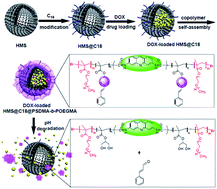ATRP-based synthesis of a pH-sensitive amphiphilic block polymer and its self-assembled micelles with hollow mesoporous silica as DOX carriers for controlled drug release
Abstract
The atom transfer radical polymerization (ATRP)-based synthesis of a pH-sensitive fluorescent polymer (PSDMA-b-POEGMA) was successfully prepared using 3,6-dibromo-isobutyramide acridine (DIA), an initiator with a fluorescent chromophore, to initiate a lipophilic monomer 2-styryl-1,3-dioxan-5-yl methacrylate (SDMA) and a hydrophilic monomer oligo(ethylene glycol) methyl ether (OEGMA), which contained a cinnamic aldehyde acetal structure. With the addition of hollow mesoporous silicon (HMS@C18), the pH-sensitive core–shell nanoparticles (HMS@C18@PSDMA-b-POEGMA) were developed via a self-assembly process as carriers for the anticancer drug doxorubicin (DOX) for drug loading and controlled release. The nanocomposites showed a higher drug loading capacity which was much higher than that observed using common micelles. At the same time, the polymer coated on the surface of the nanoparticles contains the fluorescent segment of an initiator, which can be used for fluorescence contrast of the cells. The nanocomposite carrier selectively inhibits human melanoma cell A375 relative to human normal fibroblasts GM. The in vitro results suggested that a smart pH sensitive nanoparticles drug delivery system was successfully prepared for potential applications in cancer diagnosis and therapy.



 Please wait while we load your content...
Please wait while we load your content...